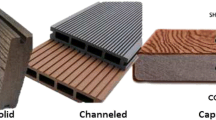Abstract
Components of polyurethane synthesis are tested for their ability to bind pine wood into boards and are compared to the efficiency of using only the isocyanate component of polyurethane synthesis. A variety of polyols are tested varying equivalent weight, functionality, reactivity as determined by the availability of primary hydroxyl endgroups, and viscosity. The boards are fabricated at a variety of densities and under a variety of conditions. The results show that board properties using only the isocyanate component are always superior to those including a polyol component, but the board properties are not always a simple function of the amount of isocyanate put in the board. Furthermore, it is observed that the lower the room temperature surface tension between the polyol and isocyanate, the better the measured board properties; but, the higher the observed surface tension, the better the board will self-release from the metal caul plates.


Similar content being viewed by others
References
American society for testing materials ASTM (1999) Standard method for evaluating the properties of woodbase fiber and panel materials. ASTM D 1037–99, Philadelphia
Bras W, Derbyshire GE, Bogg D, Cooke J, Elwell MJ, Komanschek BU, Naylor S, Ryan AJ (1995) Simultaneous studies of reaction kinetics and structure development in polymer processing. Science 267:996–999
Chapman F (1951) Synthetic resin adhesives in adhesion and adhesives. In: De Bruyne N, Howink R (eds) Elsevier, New York
Elwell M, Ryan AA, Grunbauer H, Van Lieshout H, Lidy W (1995) Structure development via FTIR spectroscopy, synchrotron SAXS and rheology during the reactive processing of flexible polyurethane foam. Plast Rub Compos Pro 23:265–276
Farrisey WJ, McLaughlin A, Waseciak D (1983) Process for preparing particleboard. US Patent 4,374,791
Gallagher JA (1978) Binder composition and process for preparing pressure molded cellulosic articles. US Patent 4,100,328
Gallagher JA (1982) Urethane bonded particleboard. Forest Prod J 32(4):26–33
Kwei TK, Wang TT (1978) Phase separation behavior of polymer–polymer mixtures. In: Paul D, Newman S (eds) Polymer blends, vol 1. Academic, San Diego
Kurt E, Haberland S (1968) French Patent 1,522,491
Maloney T (1993) Modern particleboard and manufacturing. Miller Freeman, San Francisco
Marcinko JJ, Newman WH, Phanopoulos C (1996) The nature of the MDI/wood bond. Conference paper WD-516 ICI polyurethanes, West Deptford
Marcinko J, Robertson (1996) Self releasing binder system. US Patent 5,554,438
Martin DJ, Mejis GF, Gunatillake PA, McCarthy SJ, Renwick GM (1997) The effect of average soft segment length on morphology and properties of a series of polyurethane elastomers. II. SAXS-DSC annealing study. J Appl Polym Sci 64:803–809
Plumridge PH, Vale WH (1975) Bonding wood waste with castor oil and polyisocyanates. Australian Patent 488,764
Pocius A (1997) Adhesion and adhesives technology. Hanser, Munich
Saunders K (1988) Organic polymer chemistry, 2nd edn. Chapman and Hall, London
Scholl H-J, Sachs HI, Loew G (1984) Self-releasing binder based on isocyanate and the use thereof in a process for the production of molded articles. US Patent 4,478,738
Sonnenschein MF, Cheatham CM (2002) Effect of interfacial energetics on the protection of steel and aluminum surfaces by alkyl acid coatings. Langmuir 18:3578–3584
Sonnenschein MF, Rondan N, Wendt BL, Cox JM (2004) Synthesis of transparent thermoplastic polyurethane elastomers. J Polym Sci Chem Ed 42:271–278
Wake W (1976) Adhesion and the formulation of adhesives. Applied Science, London
Wegner TH (1989) Wood. In: Mark HF, Bikales NM, Overberger CG, Menges G (eds) Encyclopedia of polymer science and engineering, vol 17. Wiley, New York
Wendler SL, Frazier CE (1996) The effects of cure temperature and time on the isocyanate-wood adhesive bondline by 15N CP/MAS NMR. Int J Adhes Adhesives 16:179–186
Zhou X, Frazier CE (2001) Double labeled isocyanate resins for the solid state NMR detection of urethane linkages to wood. Int J Adhes Adhesives 21:259–264
Acknowledgements
The authors would like to thank Dr. Doug Brune for a thorough review of this paper. We would also like to thank Dr. R. Prather for helpful conversations during the course of this work. The Dow Chemical Co. is thanked for its support.
Author information
Authors and Affiliations
Corresponding author
Rights and permissions
About this article
Cite this article
Sonnenschein, M.F., Wendt, B.L. Efficacy of polymeric MDI/Polyol mixtures for binding wood boards. Wood Sci Technol 39, 27–35 (2005). https://doi.org/10.1007/s00226-004-0266-0
Received:
Published:
Issue Date:
DOI: https://doi.org/10.1007/s00226-004-0266-0




